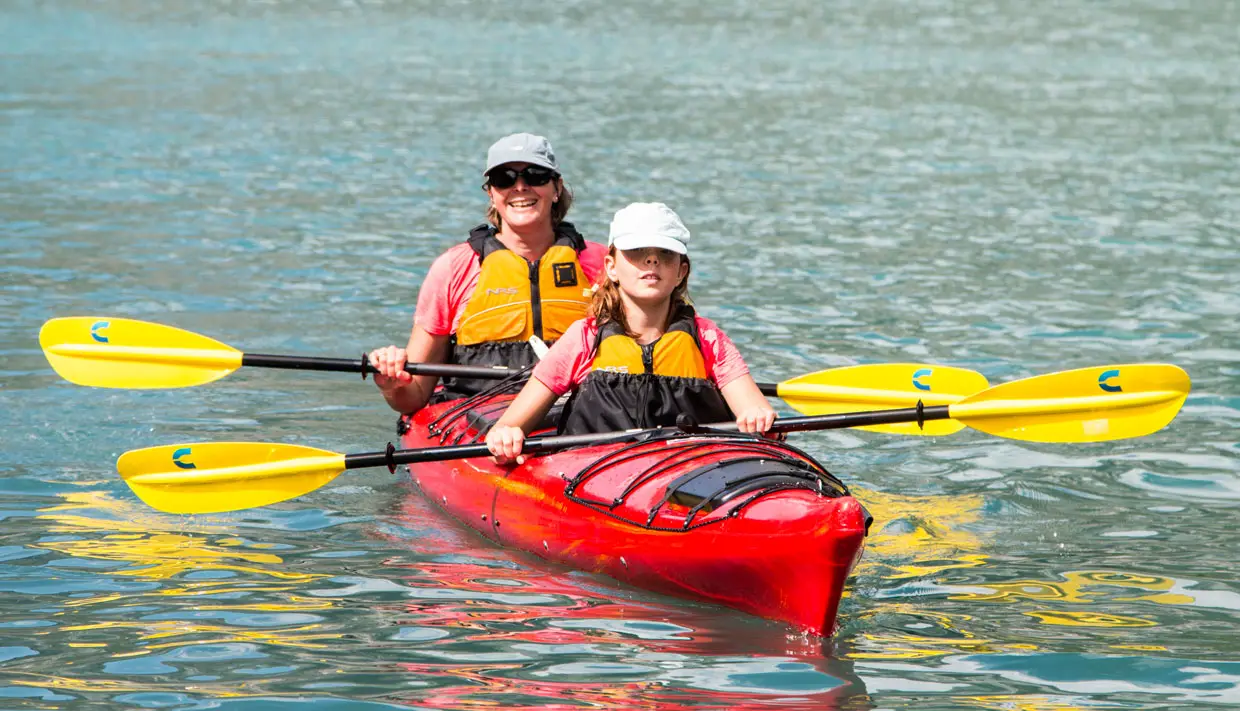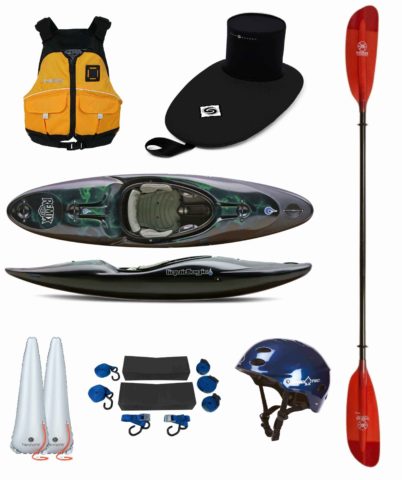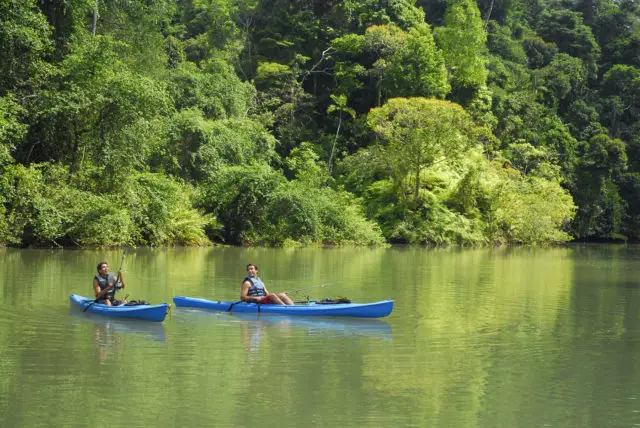The kayak is a variety of canoe for one to four crew members. In its origin as a single-seater was used for fishing and hunting. The crewmember or paddler is seated and oriented in the direction of the advance, unlike the rowing boats, and propels the boat employing a double blade shovel (paddle) that does not need support on the hull.

It is long and narrowboat. In its traditional designs it is a closed deck, only open in the “bathtub” where the paddler (s) is located. There are currently as many designs and variants as potential uses, but in general, it can be considered a small boat concerning other types, sometimes with an extraordinarily hydrodynamic compact design with much maneuverability.
Given its characteristics, kayaks can be used in calm waters (rivers, reservoirs, lakes or swimming pools), whitewater (Mountain Rivers or whitewater channels) and in the sea (even in the open sea). Such a variety of uses translates into a large number of modalities: track and river descent, whitewater, extreme kayak, rodeo, surf kayaks, sea kayak, kayak-polo and recreational, among others.
History.
The kayak has attributed an Eskimo origin, more specifically Inuit. The word would mean “man-boat” or “piece of floating wood” as it was built to suit the paddler. In the Eskimo society, minors could not use these boats and only when they reached the age of majority, in a ritual act, the family built their kayak. It was said that if an Eskimo went hunting and did not return it was because he had used a borrowed boat.
Originally, in the Arctic, the kayak was conceived as a single-person boat consisting of a wooden shell covered with skins. It is at least 4000 years old. The oldest recovered kayaks are shown today in the North American department of the Munich ethnological museum. The Eskimos also created specific garments for this activity such as anorak or so-called bathrobes which only exposed the face of the paddler.
Kayak equipment.

First, all kayaks incorporate a seat; mobile or fixed and with adjustable footrests adjustable to fit the paddler. Track, river or cruise models are usually equipped with a rudder. The orza is located in the back third of the boat and is controlled with the feet by pedals or a crosshead and slat system, in fiber or wood. The orza and other control systems are connected by a cable or a thin and tense rope that allows the control to be transmitted. Finally, whitewater or cruise models usually incorporate watertight compartments and systems to fix a certain amount of cargo on the boat. In some models, there is the possibility of incorporating a small sail, especially in cruise kayaks.
Personal equipment.
For paddling in calm waters besides
adequate clothing to the particular environment and the climate, a garment made
of waterproof material that prevents water from entering the interior of the
boat is used employing fixing this elastic to the opening of the “bathtub”
(hull).
The use of a life jacket and thermal waterproof vests is always recommended if
the weather conditions advise.
The practice of whitewater requires more complex equipment. It is mandatory to wear a helmet, life vest, neoprene clothing and footwear appropriate to the environment; either booties or similar water shoes. Depending on the case, the use of specific safety and rescue equipment may be essential. For example safety ropes harnesses or extra flotation elements.
Maneuvers of the kayaker.
Among a large number of maneuvers and their variants, some of them can be considered common to other sports disciplines, such as surfing or rowing. Others, a certain number, will be specific to the kayak; for example:
Eskimo taje: the most popular without a doubt, the essential maneuver of the Eskimos. The accidentally overturned paddler can recover the verticality using the shovel as a lever on the water and through a hip stroke. It will be a maneuver typical of whitewater kayaking, surfing or sea kayaking;
Paddling by the wave: where the paddlers take advantage of the wave that the kayak (or canoe) of another paddler naturally generates when moving. It can be taken in a lateral position and slightly delayed in front of the reference paddle or standing very close to the bow The taking of the wave allows receiving a certain thrust from it and it moves forward with less resistance. Receiving the thrust in the opposite direction allows advancing with greater resistance. This wave capture is characteristic of medium and long-distance kayaking competitions (3000 to 28000 meters) where you can see the curious rhombus formations adopted by groups of paddlers who seek the wave of their competitors and avoid the area of anti-waves.
Support: the paddler uses the shovel not as a propellant but as support to achieve a better balance, to reduce the speed of the boat or to force a quick maneuver of the kayak. The supports in their very diverse forms are used both in calm waters and especially in whitewater and in the sea where turns and changes of direction are more frequent.
Re-paddle: a maneuver where a lateral displacement or a fast turn of the boat is sought, in this case using a propulsion technique and not of support. The paddle, now as a propulsion tool, is normally rotated concerning its normal position from a remote position. Sometimes describing a curved path (circular blade). To achieve a quick and effective response of the boat, the repairing paddler usually reinforces his action, turning, pushing with his hip and shifting the weight of his body towards the paddle.
Both whitewater and sea kayak modalities have specific maneuvers for each. Regarding the whitewater or freestyle kayak, the paddlers can perform loopings, forward and backward, using the force of the current as an aid; the surf modalities or their variants will be able to execute loopings and catch the sea waves just like surfers would do on their board.
Kayaking in Costa Rica.

Kayaking in our country is truly an unforgettable experience. It is a fantastic trip for enjoying the breathtaking views that are close to our rivers and oceans. Costa Rica has many of its beaches and rivers suitable for you to practice kayaking and explore new places, being able to be captivated by nature and biodiversity that this land has to offer.
You can enjoy kayaking in the rapids entering the Pascuare and Reventazón rivers near the city of Turrialba in the Central Valley. Another excellent destination for travelers in search of is the Sarapiqui River, located in the northeast region of the country. This area is the ideal place for tourists to plan these kinds of trips since several specialized companies offer tours that include equipment, food, lodging, and even bilingual guides. More experienced travelers can bring their equipment.
Also located in the northern region of Costa Rica are the La Fortuna and Arenal rivers, which provide fantastic opportunities to observe the most diverse flora and fauna of the country. With gigantic trees hanging above the water, the Fortuna River is an ideal place to see several species of monkeys in the trees as well as foxes and a large number of birds.
The Arenal River, which provides lush views of the Arenal Volcano, is known for its forests and dense areas of vegetation that surround it. Kayaking or canoeing on this river is another excellent way to get to know other wildlife species in the country. Another amazing place to go kayaking in the mangrove zone of Piedras Blancas National Park. Here you will find a wide variety of wildlife that can add to the absolute pleasure and tranquility of passing through the mangroves.


